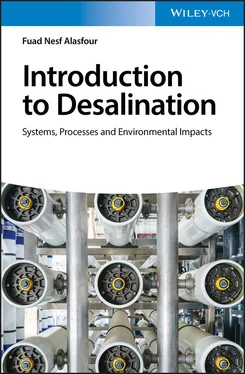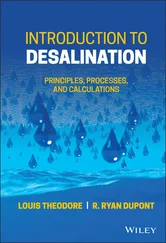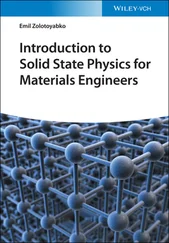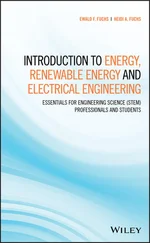|
MEE |
MSF |
MEE‐TVC |
MVC |
RO |
ED |
| Typical unit size (m 3/d) |
5000–15 000 |
50 000–70 000 |
10 000–35 000 |
100–2500 |
24 000 |
−145 000 |
| Steam pressure (atm) |
0.2–0.4 |
2.5–3.5 |
0.2–0.4 |
— |
— |
— |
| Electrical energy consumption (kWh/m 3) |
1.5–2.5 |
4–6 |
1.5–2.5 |
7–12 |
3–7 |
2.6–5.5 |
| Thermal energy consumption (kJ/kg) |
230–390 |
190–390 |
145–390 |
None |
None |
None |
| Electrical equivalent for thermal energy (kWh/m 3) |
5–8.5 |
9.5–19.5 |
9.5–25.5 |
None |
None |
None |
| Total equivalent energy consumption (kWh/m 3) |
6.5–11 |
13.5–25.5 |
11–28 |
7–12 |
3–7 |
26–5.5 |
1.6 Thermo‐Physical Properties of Water
1.6.1 Potable Water
Potable water (freshwater) is characterized with salinity less than 500 ppm.
Table 1.2shows water classification based on salinity, and the standards of WHO for freshwater limit is 500 ppm (0.05 mg/kg).
Table 1.2Water classification based on salinity content.
| Type |
Total dissolved salts (TDS) |
| Freshwater |
<1500 |
| Brackish water |
1500–10 000 |
| Salt water |
>10 000 |
| Seawater |
10 000–45 000 |
| Standard seawater |
35 000 |
The chemical concentration in fresh water with 500 ppm are shown in Table 1.3.
Table 1.3 Secondary drinking water regulation [5].
| Chemicals |
SDWR |
| Aluminum |
0.05–0.2 mg/l |
| Chloride |
250 mg/l |
| Color |
15 color units |
| Copper |
1.0 mg/l |
| Corrosivity |
Non‐corrosive |
| Fluoride |
2.0 mg/l |
| Foaming agents |
0.5 mg/l |
| Iron |
0.3 mg/l |
| Manganese |
0.05 mg/l |
| Odor |
Three threshold odor numbers |
| pH |
6.5–8.5 |
| Silver |
0.1 mg/l |
| Sulfate |
250 mg/l |
| Total dissolved solids (TDS) |
500 mg/l |
| Zinc |
5 mg/l |
Tables 1.3and 1.4show the 2018 Drinking Water Standards and Health Advisories, Secondary Drinking Water Regulations.
Table 1.4WHO standards for potable water [5].
| Constitutes |
Concentration (ppm) |
| Limited values |
Max allowed values |
| Total dissolved salts (TDS) |
500 |
1500 |
| Cl |
200 |
600 |
| SO 4 2+ |
200 |
400 |
| Ca 2+ |
75 |
100 |
| Mg 2+ |
30 |
150 |
| F − |
0.7 |
1.7 |
| NO 3− |
<50 |
100 |
| Cu 2+ |
0.05 |
1.5 |
| Fe 3+ |
0.10 |
1.0 |
| NaCl |
250 |
— |
| pH |
7–8 |
6.5–9 |
Table 1.5Thermo‐physical properties of typical seawater at 40 000 ppm and 20 °C.
| Density |
1.0288 kg/m 3 |
| Specific heat capacity |
3.973 kJ/(kg °C) |
| Boiling point elevation, at 20 °C |
0.344 K |
| Boiling point elevation, at 90 °C |
0.565 K |
| Thermal conductivity |
0.601 W/(m K) |
| Dynamic viscosity |
1.089 × 10 −3kg/(m 2s) |
| Kinematic viscosity |
10.58 × 10 −7m 2/s |
| Latent heat of vaporization |
2355.4 kJ/kg |
Table 1.5shows thermo‐physical properties of standard seawater at 40 000 ppm and 25 °C.
Note that the comprehensive thermo‐physical properties of seawater as a function of temperature and salinity are presented in Appendix A.
The major six elements that comprise about 99% of seawater are chlorine (Cl −), sodium (Na +), sulfate (SO 4 2−), magnesium (Mg +2), calcium (Ca +2), and potassium (K +), and standard seawater composition at 35 000 ppm are presented in Table 1.6.
Table 1.6Standard seawater composition at salinity equal to ≈35 000 ppm.
| Chemical ion |
Concentration (ppm) |
Valence |
Total salt content (%) |
mmol/kg |
Molecular weight |
| Chlorine Cl − |
19 345 |
−1 |
55.03 |
546 |
35.453 |
| Sodium Na + |
10 752 |
+1 |
30.59 |
468 |
22.990 |
| Sulfate SO 4 2− |
2701 |
−2 |
7.68 |
28.1 |
96.062 |
| Magnesium Mg 2+ |
1295 |
+2 |
3.68 |
53.3 |
24.305 |
| Calcium Ca 2+ |
416 |
+2 |
1.18 |
10.4 |
40.078 |
| Potassium K + |
390 |
+1 |
1.11 |
9.97 |
39.098 |
| Bicarbonate HCO 3 − |
145 |
−1 |
0.41 |
2.34 |
61.016 |
| Bromide Br − |
66 |
−1 |
0.19 |
0.83 |
79.904 |
| Borate BO 3 3− |
27 |
−3 |
0.08 |
0.46 |
58.808 |
| Strontium Sr 2+ |
13 |
+2 |
0.04 |
0.091 |
87.620 |
| Fluoride F − |
1 |
−1 |
0.003 |
0.068 |
18.998 |
| Σ x i= 35 151 ppm |
Note that Cl makes up to 55% of salt in seawater and NaCl makes up to 86% of salt in seawater.
Example 1.5 Heat Exchanger with Feed Seawater
An adiabatic heat exchanger provides thermal load to feed seawater, such that feed seawater can be supplied to MEE desalination system at 70 °C.
Steam stream: 1 kg/s, 120 °C
State 1: saturated vapor
State 2: saturated liquid
Feed seawater stream:
State 3: 20 °C
State 4: 70 °C
x f= 40 000 ppm

Find:
1 Feed seawater flow rate.
2 Assume feed is fresh water, find feed flow rate.
3 If steam (thermal load) is generated by conventional boiler using natural gas as a fuel, find fuel flow rate and emitted amount of CO2.
4 Provide emission table for three types of fuels to generate steam (thermal load).
1 Energy balance (first law): of thermal load (≈11 time of steam flow rate).Alternative solutioncp is calculated at then kg) of thermal load.
2 If feed is fresh water
3 The of natural gas fuel.For CO2 emission
4 Environmental impact of burning fossil fuels.
| Fuel |
Calorific value (MJ/kg) |
CO 2(kg/kg fuel) |
CO 2/energy (kg/MJ) |
SO 2(kg/kg fuel) |
| Coal |
26 |
2.361 |
0.091 |
0.018 |
| Fuel oil |
42 |
3.153 |
0.075 |
0.040 |
| Natural gas |
55 |
2.750 |
0.050 |
0 |
Extra activity:
Student can perform the following:
1 Perform parametric study to investigate the effect of on . Plot and explain.
2 Perform parametric study to investigate the effect of xf on . Plot and explain.
Читать дальше





![Andrew Radford - Linguistics An Introduction [Second Edition]](/books/397851/andrew-radford-linguistics-an-introduction-second-thumb.webp)







